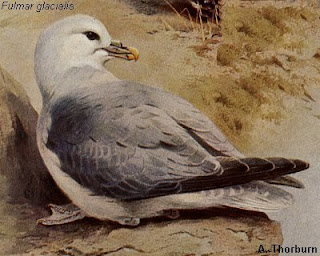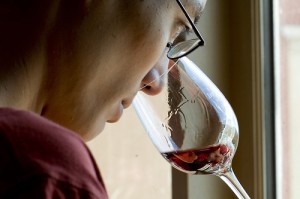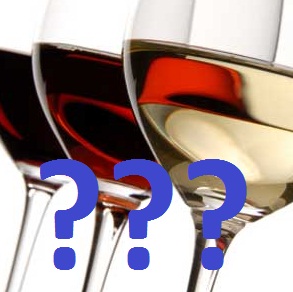“Like” The Academic Wino on Facebook by clicking here!
Follow The Academic Wino on Twitter by clicking here! (@TheAcademicWino)
Studies on olfactory influences on physiological and neurological responses are not new to science. It has been found that 80% of flavor sensations during eating in humans are attributed to the olfactory system (i.e. smelling). It is also well known that in humans, and many other living things with functioning olfactory systems, the sense of smell also acts as a sort of defense mechanism against possible threats.
 |
| http://www.earthlife.net/birds/images/procellariiformes/fulmar.jpg |
For example, something very foul smelling may trigger a defensive response, as the smell may indicate danger or poison if ingested. Evolution has taken advantage of these responses over time, which can be seen in the example of the Fulmar bird. The Fulmar, which is closely related to the Albatross, is an extremely foul-smelling bird, with even smellier eggs. This provides the bird with protection against most predators, as the stench will nearly always trigger a danger response in the predator thus leaving the bird and/or eggs unscathed.
I realize I’m getting away from wine quite a bit, however, it is important to note that responses to olfactory cues (i.e. the aroma of that wine you have in your glass) have an underlying evolutionary and physiological origin that is common across many different living systems. Also, I’m kind of a geek and love sharing my random knowledge of science.
Anyway, I digress….
It is known that olfactory cues from food can alter one’s impression of the food. Does it smell good to you? This may trigger a positive response in your brain. Does it smell like rotten eggs? This may trigger a warning signal in your brain to not eat it due to possible danger. Olfactory triggers in the brain are distributed via two major pathways: through the limbic system and the frontal cortex. The first pathway, through the limbic system, influences the signals made by the hypothalamus and pituitary gland in the brain, and by which olfactory responses can alter mood and behavior without the individual being consciously aware of the change. The second pathway, through the frontal cortex, is where the conscious decisions occur and are processed with past memories and experiences to help make a determination of the identification of the odor.
 |
| http://cheriwalters.com/wp-content/ uploads/2010/03/smelling-wine-300×199.jpg |
When it comes to wine, the aroma is often assessed to determine wine quality as well as one’s likeability of the wine. Studies have shown even the hunger level experienced by the person smelling the wine can change how one feels about the aroma and therefore the quality/likeability of the beverage.
Earlier this year, a team of Japanese researchers set out to study the decision-making process for selecting one’s favorite wine by using olfactory cues as well as physiological and neurological markers. To tell you the truth, I had a hard time with this paper, which I think can be partially blamed on the poor translation. Several times, what I was reading was not coherent sentences, which forced me to interpret what they were trying to say. Though the paper in and of itself was not the most properly edited, the topic is one I don’t see come up as often as others and so I wanted to share it with you all today.
Experiment I: Mental Impressions of Wine
For the first part of their experiment, the researchers had subjects smell wines to determine certain characteristics without tasting them. They recruited 24 students with no wine knowledge, and divided them up into a wine lovers group, and a non-wine lovers group. Subjects were asked to smell the wines, then answer a questionnaire in which they had to give the wines one of five criteria: “refreshing”, “amiable”, “favorite”, “delicious”, and “poised”.
The research team used analytical hierarchical process (AHP) to analyze the qualitative and quantitative aspects of a decision made on the wines, which according to the authors, has not yet been used in this type of experiment with wine. AHP is a mathematical technique that is used for multi-criteria decision-making processes. The decision problem is presented as a structure hierarchy, with the overall goal/decision positioned at the top. The next level of the hierarchy consists of criteria relevant to this overall goal/decision, while the bottom level are the alternatives being evaluated (the different wines in this example). This method of analysis, coupled with Principle Components Analysis (PCA) allowed the researchers to determine the subjects’ preferences for each wine.
Experiment II: Neuro-physiological responses to wine aromas
For this experiment, 16 subjects (8 wine lovers and 8 non-wine lovers) were seated in an environmentally-controlled room with the edge of a wine glass placed on a stand 10 centimeters under the nostril for the subjects to sniff. Subjects were presented with a non-odor solution, an alcoholic solution, and seven different wines. Solutions and wines were presented to subjects for three minutes at one minute intervals in a random order. Each subject underwent this experiment twice. Blood-oxygen levels were also measured, which were done so by using NIRS and EEG measuring caps.
 |
| Figure 2 from Koike et al, 2012. |
As an aside, I wanted to point out an example of the awful translation/editing done on this paper. Figure 2 shows an image of the experimental set up for Experiment II. Notice anything odd in this picture? Wine by the Grass? Really? I swear, I did not alter this photograph in any way shape or form. Here is the icing on the cake: to describe the image in detail, the text read something like this: “…the edge of a blade of grass kept on a stand was placed under 10 centimeters from the nostril for the subject to sniff the wine aroma”. I’m sorry, but was there not a single person that could speak any English editing this translation? You can’t make this stuff up.
Again, I digress….
So what did this study find?
- This study found that for wine lovers, the criteria of “Favorite” was rated of highest importance in both empty and moderately empty stomach conditions, while the criteria “Poised” was rated lowest.
- Not surprising, “Amiable” and “Delicious” were rated higher in empty stomach conditions than in moderately empty stomach conditions.
- For wine lovers and non-wine lovers, the highest ranked wine was Wine #3 and Wine #5 for both stomach conditions.
- For wine lovers with the moderately empty stomach condition, Wines #3 and #5 at first significantly increased blood-oxygen levels compared to the non-odor solution in the left and right sides of the subjects’ foreheads, respectively.
o Wine #3 significantly changes blood-oxygen levels at 2 and 3 minutes compared to the non-odor solution.
o For non-wine lovers, blood-oxygen levels remained unchanged.
- For wine lovers with the empty stomach condition, blood-oxygen levels increased in the third minute when Wine #3 was given.
o For non-wine lovers, blood-oxygen levels remained unchanged.
So, what does this all mean?
The primary result of this study was that both wine lovers and non-wine lovers identified Wine #3 as their “favorite” wine, followed by Wine #5. The study also found that blood-oxygen levels significantly increased for wine lovers in the third minute of exposure to the wine aroma for Wine #3 compared to non-odor and alcoholic solutions. However, for the non-wine lovers, this increase in blood-oxygen level was not found, and instead no significant changes were noted. According to the authors of this study, these results indicate that there is a discrepancy between the psychological expression and the physiological response when smelling wine.
Some studies have found that there is a differing cortical response to the expectation of eating food when the subject was hungry versus full. This study found that blood-oxygen levels decreased from seconds in empty stomachs to minutes in moderately empty stomachs, possibly indicating that the reward response to the wine aroma was decreased and satisfied. In other words, smelling the wine on an empty stomach more quickly satiated the subject than smelling the wine on a fuller stomach, since a fuller stomach is already more satisfied.
It is important to note that this blood-oxygen response was only found with wine lovers. With non-wine lovers, there was no significant change in blood-oxygen levels when presented with wine aromas. According to the authors, this may indicate that non-wine lovers are satisfied by wine aroma. In other words, they may not feel any sort of pleasurable emotion when smelling wine.
“The Big Reveal”
Which wines were Wine #3 and Wine #5, the “favorites” identified by the subjects in this study. Wine #3 turned out to be wine made from Niagara grapes, and Wine #5 was made from Campbell Early grapes; both grapes belonging to Vitis labrusca and having sweet aromas and sweet tastes. The other wines not ranked as highly by the study subjects were Vitis vinifera and dry. The authors suggest that the sweet aroma of the two “favorite” wines for subjects in this study could be leaving a psychological positive impression on them.
What do I think?
Perhaps is preference again due to the evolutionary development of a scent-based defense mechanism. Maybe a sweet smell triggers a positive response that there is something good to eat present, while an astringent or bitter smell (as one may find in some dry wines) may trigger a more negative response indicating to the individual that poison or danger may be afoot.
 |
| http://wine-zag.com/wp-content/ uploads/2011/01/what-wine-do-I-like.jpg |
This preference could also be attributed to the study subject population. The study subjects were students (i.e. young and inexperienced) with no prior wine knowledge other than knowing whether or not they liked wine at all. Since they have not yet had many wine experiences, these results could be related to the fact that inexperienced wine drinkers tend to gravitate toward sweeter wines than drier wines.
Overall, while the results may be interested from a purely scientific standpoint, they can in no way be extrapolated to any other population. The study subjects were (assumingly) all Japanese students, the age of which I am assuming is relatively young. The study subjects are all very inexperienced in wine. Also, the sample size was extremely small, with only 16 subjects participating in Experiment II. The results of this study can only therefore be interpreted for this tiny subset of a population and cannot be assumed to be the reality for other populations. Would the results of this study be the same as if it were repeated on French wine experts? I highly doubt it (though I could be wrong…).
I am also very disappointed with the quality of editing and the translation of this paper. Some of the mistakes are cringe-worthy (see Figure 2 above) and should absolutely have not passed through the editors without so much as a “hey, that doesn’t make that much sense…”. I’d also like to see the study repeated using a larger and more diverse population (including not only wine novices but also wine experts and general wine enthusiasts). Finally, what about taste? Though olfactory cues are a huge player in determining preferences, one cannot forget about taste. Do decisions made solely by olfactory cues change when taste is introduced?
I’m certain there are many other things that could be improved in this study, but I’ll leave that up to you all to suggest in your comments below. What do you think about this topic and this research? Please feel free to leave your comments below!
References:
Koike, T., Kamimura, H., Shimada, K., Yamada, H., and Kaneki, N. 2012. Determination of Favorite Wine from Comparison of Wine Aroma Attributes. Kansei Engineering International Journal 11(1): 41-50.
http://www.fivesenses.com/Documents/Library/5%20%20Future%20Olfactory%20Research.pdf Accessed 09/03/2012
http://listverse.com/2010/12/23/10-birds-with-truly-odd-defenses/ Accessed 09/03/2012
I am not a health professional, nor do I pretend to be. Please consult your doctor before altering your alcohol consumption habits. Do not consume alcohol if you are under the age of 21. Do not drink and drive. Enjoy responsibly!

2 comments for “Determining Wine Preferences by Olfactory Cues and Aromatic Attributes”